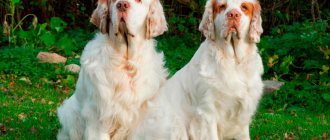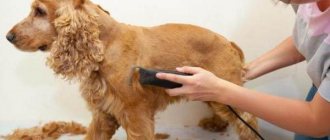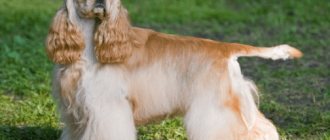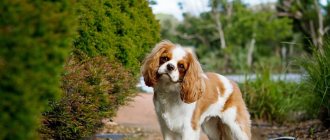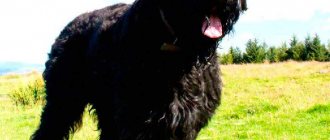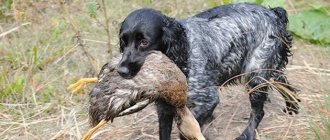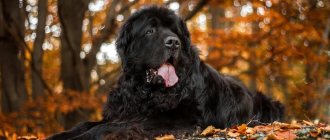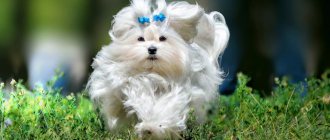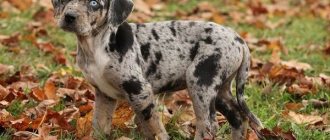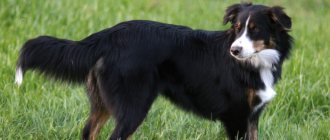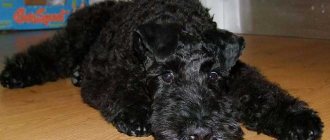Description of the Russian hunting spaniel breed
Popularity 114th place among 263 dog breeds
Lifespan:
12-14 years old
Breed group:
Hunting
Height:
males: 38-44 cm, females: 36-42 cm
Country of origin:
USSR
Average price:
from 15 thousand rubles
Weight:
13-16 kg
Latest articles Cat health
Ataxia in cats: what is it, how does it manifest and is treated 01/23/2022 187 0 0
Cat health
Leukemia, or viral leukemia in cats 01/23/2022 162 0 0
Vaccination schedule
| Age | Nobivak vaccine | Eurikan vaccine |
| 7 weeks | Deworming | |
| 8-9 weeks (vaccination against plague, viral hepatitis, adenoviral infections, parvovirus enteritis, parainfluenza, leptospirosis) | DHPPiL | DHPPI2+L |
| 11 weeks | Deworming according to indications | |
| 12 weeks (vaccination against plague, viral hepatitis, adenoviral infections, parvovirus enteritis, parainfluenza, leptospirosis + rabies vaccination) | DHPPiL+R | DHPPI2+RL |
| 1 year | DHPPiL+RL | DHPPI2+RL |
| Vaccinations are then repeated annually at the same time. |
Advantages and disadvantages
- Pros:
- smart, brave, loyal, obedient;
- gets along well with children and other pets;
- not aggressive and not vindictive, rarely shows anger;
- can be kept in a house or small apartment;
- has excellent hunting abilities and a keen sense of smell.
- Minuses:
- overly energetic and active, therefore needs long and frequent walks;
- susceptible to obesity and food allergies;
- requires special care for the coat and ears, and often suffers from otitis media.
What to feed a spaniel puppy (1 month)
The first month of a puppy’s life is considered the most important period, which plays a key role in the formation of the future pet. It is important to provide your four-legged family member with proper nutrition, care and attention. Otherwise, he will simply lose his external advantages, begin to develop poorly or begin to be capricious. The same applies to 2-3 month old individuals that are actively growing and need the right attitude. By the way, the question: “what to feed a spaniel puppy at 2 months” is often raised on various forums and resources where topics of raising pets are discussed.
Key facts
The Russian Spaniel is an energetic, lively, inquisitive, optimistic and friendly pet. Nature has endowed the dog with excellent sense of smell and amazing endurance, which allows it to quickly and easily find birds in marshy or dry areas.
The spaniel is an incredibly smart, loyal and obedient dog that is strongly attached to its owner. He gets along well with small children, cats, dogs, and other pets. Such a pet will be an ideal companion for an active family and is definitely not suitable for elderly and constantly busy people.
Description of the Russian Hunting Spaniel breed includes:
- high level of intelligence;
- friendliness, sociability;
- well developed hunting qualities;
- easy training and education;
- rapid adaptation to a new environment;
- unpretentiousness in everyday maintenance, nutrition, care.
If the spaniel is considered in the role of a hunter, it is worth noting such qualities as: perseverance, activity, endurance and complete obedience. The pet swims well in water, dives, and follows all the owner’s commands if it is raised correctly.
The characteristics of the Russian hunting spaniel breed emphasize that this hunting dog is hardy, energetic, patient, persistent and at the same time attached to the owner and his family.
With proper maintenance and proper nutrition, the life expectancy of the Russian Hunting Spaniel is 9-11 years. For a hunting dog this is a normal period. Long-livers occur, but not so often.
The spaniel tolerates cold well, which makes it possible to keep it in the enclosure of a private house. In the winter season, the owner needs to take care of insulating the booth, since without the proper conditions the dog can get sick.
How does the American Cocker Spaniel differ from other spaniels?
Spaniels are an ancient breed of hunting dogs. As the name suggests, it comes from Spain. In the Middle Ages it came to England, and from there it spread throughout the world. There are many varieties of spaniels, from decorative ones measuring 28-30 cm to large water dogs measuring 50-60 cm at the withers. The differences between the species are very noticeable in appearance, so they were separated into separate breeds. Among them, 10 varieties are popular.
They were bred in different countries, as can be seen from the name. There are English, American, German, Irish, Japanese spaniels. They also differ in purpose: decorative, water, cockers, springers.
In addition to cocker spaniels, there is another variety bred in the USA - the American water spaniel. You can immediately distinguish him from a cocker: he is tall and has curly hair. This is a strong, resilient dog, capable of becoming a guard, watchman, and rescuer.
Differences between English and American Cocker Spaniel
Most of all, the American spaniel is similar to the English one, from which it originated. The difference between them is small. The breeds were separated only in the 30s of the 20th century. The main difference is working qualities. While the English Spaniel still has hunting abilities, the American Spaniel is more of a decorative dog and companion. When breeding, breeders paid attention mainly to appearance. Having studied the description of the breeds, you can find the following differences:
- English is taller, the head is large and elongated;
- the American has thicker and longer hair, a shorter muzzle, and larger ears;
- English spaniels are more active and can be aggressive towards strangers, while Americans are calmer and good-natured.
The photo shows the differences between different types of spaniels:
On the left is an English Cocker Spaniel, on the right is an American
History of the origin of the Russian hunting spaniel
The animal appeared on the territory of the Russian Federation during the reign of Nikolai Romanov. He was an avid dog breeder and brought various breeds of hunting and guard dogs from abroad. The result of crossing the Italian spinone and the long-haired pointer was the birth of the Russian spaniel, which, at the instigation of the tsar, acquired practical value among domestic dog breeders.
The animals were quickly discovered to have remarkable hunting qualities and the ability to work with game and birds on land and water. In particular, they were often used in catching pheasants, a favorite dish of the imperial family. For this reason, breeding hunting breeds has become a profitable and respected business.
English dog breeders were also involved in selection: they mixed spaniels from the royal nurseries with cocker spaniels. The result was offspring that had some external similarity with their Russian relatives and had similar working qualities.
By the middle of the 20th century, through repeated crossing, breeders developed two breeds of spaniels with significant distinctive features, which are exhibited separately at breeding shows. At the same time, the unofficial English and Russian groups split.
The four-legged representatives of the “castes” differ in appearance and principle of operation, which became the reason for the subsequent mixing of both species. Subsequently, Leningrad cynologists were engaged in breeding spaniels, who bred domestic and imported dogs from abroad, significantly improving the hunting breed.
However, all their achievements were destroyed by the blockade of Leningrad during the Second World War, which is why, after the victory over the Nazis, the number of dogs had to be restored almost from scratch.
In 1950, Soviet cynologists determined the phenotype of the hunting breed and registered the standard for the appearance of the spaniel. Since 1971, mating Russian hunting dogs with other breeds of spaniels was officially prohibited, and this made the breed independent.
In the early 60s of the last century, dogs became very popular among Soviet hunters. Smart, loyal, obedient pets were and remain easy to transport; they take root well in small apartments.
At the moment, the animal population numbers more than 60 thousand individuals; the main breeding centers of the breed remain: Moscow, St. Petersburg, Yekaterinburg, Saratov, Samara. To improve knowledge about the hunting breed in America, the Spaniel Club was opened in 2000, where spaniel owners can register their four-legged friends.
Story
The lack of a dog suitable for the Russian climate forced breeders to think about independently breeding a suitable breed. They selected the longest-legged representatives of the breed, imported sprinters from Europe in order to improve the livestock with their blood. This process was repeated over several breeding periods, resulting in spaniels that did not fit the standard English breeds.
By the thirties of the last century, Russia had many dogs that did not fit the standards of the breeds available at that time, but had common characteristics. Nevertheless, it was too early to talk about the emergence of a new breed that would meet the needs of hunters.
Full breeding work began after the Second World War, and in 1951 the original breed standard was introduced. The final, slightly modified standard appeared in 1966.
Appearance of Russian hunting spaniels
General impression
In life and in the photo, the Russian hunting spaniel is a strong, muscular dog of an elongated format. At the withers it is taller than English Cocker Spaniels, but smaller than the Springer.
Since Soviet breeders paid main attention to endurance, courage, and search characteristics, the eared animal looks a little primitive. Of course, he is far from the glamorous Americans, but he is not without restraint in grace and lightness of charm.
Head
Oval in shape, elongated, wide, with a well-defined skull, the head of the Russian Hunting Spaniel is quite large, while it tapers towards the nose. The forehead is convex, the arches above the eyebrows are well developed. The line of the muzzle is parallel to the line of the forehead. The transition between them is noticeably pronounced.
If you look at the head from the side, you can see that the upper lip is shaped like a rectangle with slightly rounded corners. The lips and nose are black or light brown.
Neck
Moderately long, well developed muscles.
Torso
Sturdy and slightly elongated. The topline is sloping, the back is wide, the loin is short, smoothly turning into a sloping croup. The chest bone is wide, the pelvis is taut.
Front and hind limbs
The front legs are straight, bony and parallel. Elbows set back. The forearms are straight, the pasterns are voluminous, slightly inclined. The length of the legs is ½ the height of the animal at the withers.
The hind limbs are straight and spaced slightly wider than the front ones. The spaniel has short shins and voluminous, straight-set metatarsals. The paws are rounded and arched, the toes are pressed tightly against one another, separated only by long hairs.
Tail
Mobile, thickened at the base. It decreases by half after birth and is located along the line of the back when walking.
Movements
Free, energetic. Animals move well both on land and in water.
Wool
The coat is elongated and noticeably wavy. The guard hair is shiny and adheres well to the animal's body. The head and all limbs are covered with a short and dense coat.
There are longer hairs on the back, croup, sides, and top of the neck. The chest, lower neck, groin and back of the paws are covered with abundant hair, forming dewlaps.
Colors of the Russian Hunting Spaniel
The breed is characterized by 3 types of colors: uniform, 2- and 3-color. Animals with solid colors are dark red, brown, black, and white markings on the throat or sternum are acceptable.
Two-tone spaniels combine similar colors, but they are broken up with distinct light spots. Tricolor - black and white, brown pets with a slight tan. The color may contain inclusions that do not match the main tone of the coat.
Russian hunting spaniel size
The height of the Russian Hunting Spaniel at the withers for males reaches 39-45 centimeters, for females – 35-40 centimeters. The weight of a Russian hunting spaniel in adulthood does not exceed 22 kilograms.
Weight table by month
Next is a table that will help owners of small cocker spaniels track their pet’s weight gain.
| Age (month) | Weight (kg) |
| 1 | 1,5 |
| 2 | 3-3,5 |
| 3 | 5-6 |
| 4 | 6,5-8 |
| 5 | 8-10 |
| 6 | 9-11 |
| 7-9 | 9-12 |
| 10-12 | 10-14 |
As for the sizes of already mature, mature animals:
- Males: weight - 12-15 kg, height at withers - 40-43 cm.
- Females: weight - 11-14 kg, height at withers - 38-41 cm.
Character of the Russian hunting spaniel
The Russian spaniel is a wonderful hunter, but in the house the dog becomes a devoted, reliable friend and companion for all family members. He quickly becomes attached to a person and tries to accompany him everywhere.
The dog loves to swim, play and frolic. If the animal is kept in a country house, it must be allowed to run freely around the site or a large fenced space.
The spaniel gets along well with small children and happily gives them all his free time. He runs, jumps, plays, and carries out all the orders of his little masters. You can leave your pet unattended with your child, as the spaniel is very friendly and would never cause any harm to his young friend.
The spaniel treats other pets in the home with patience, but he certainly won’t show the same respect to other people’s cats and will definitely kick them out of the entrusted territory. The dog does not get along with guinea pigs, hamsters, birds - the hunting instinct takes over over time, and small animals die.
In general, this is an intelligent, hardy, strong, active pet with a remarkably developed instinct of a born hunter. The character of the Russian hunting spaniel is peace-loving, loyal, accommodating, he is easy to train, loves unrequitedly and completely obeys a person.
How to toilet train
The puppy cannot be taken outside during quarantine after vaccinations, so it is important to accustom him to the toilet in the house so that he does not shit in inappropriate places.
The most effective way is to limit the pet’s space by allocating it a separate room or part of the room, where the floor will be completely covered with sanitary diapers or newspapers..
This will not allow the puppy to relieve itself by. Gradually you need to reduce the number of diapers, leaving only 1 at the end, which over time can be moved to the place reserved for the toilet.
If it is impossible to limit the dog's space, it is necessary to spread diapers throughout the apartment or house, especially near doors and windows.
It often happens that a puppy, despite all the diapers, goes to the toilet in a certain place that, for some reason, he chose on his own; in such a situation, it is important to lay the diaper there, even if it is not entirely convenient for the owner.
When the pet gets used to relieving itself on the diaper, it can be moved to another place.
CAREFULLY!
The puppy should be taken to the diaper after sleeping, eating and active games and should not be allowed to leave until he relieves himself.
You can use special sprays, the effect of which is aimed at toilet training your pet - they need to be sprayed on a cloth or piece of paper and placed on a diaper.
The spray emits a specific aroma that is captured by dogs' sensitive sense of smell, indicating the correct place for the toilet..
After the end of quarantine, your pet can be trained to use the toilet outside. To do this, the dog needs to be taken for a walk in the morning and every 40-60 minutes. after feeding and wait until he goes to the toilet.
Education and training
As a rule, spaniel puppies acquire their own home and owner by 3 months of age. In the first days, the owner needs to show the baby as much attention, care and patience as possible, realizing that parting with the mother was not easy.
The puppy quickly gets acquainted with the new living conditions, its inhabitants and ceases to be afraid of extraneous sounds. Already at this time, the owner needs to start disciplining the pet - without shouting or physical punishment, teach it standard commands.
It is important to realize that a hunting dog must grow up obedient, it must have one owner with unquestionable authority. For this reason, one person takes part in training a pet, and not the whole family. It is unacceptable when someone forbids something to a dog, while another, on the contrary, allows and encourages it.
From the very beginning, the dog needs to be given a place to eat and sleep. You should not allow her to sleep on her owners’ bed or eat human food from the table. It is almost impossible to re-educate a pet after bad habits have formed.
Raising and training a Russian hunting spaniel is a labor-intensive, but very interesting task. The animal grasps everything new on the fly and completely obeys its owner. When training, it is important to use several methods that force the spaniel to remember commands:
- incentive
– when the desired action is encouraged by a treat;
- mechanical
– in studies, force is used (for example, pressing on the body, but in no case a blow);
- contrasting
– the two previous methods are combined;
- imitative
– an inexperienced dog copies the actions of a trained dog.
After mastering the training course, the spaniel will follow orders without the use of force or treats. The dog must be praised for every excellent result. Excessive punishment for disobedience is unacceptable, otherwise there is a high risk of completely losing contact with the pet.
Physical punishment can be light pressure on the dog’s back, a gentle blow to the rump with a wooden rod with a dissatisfied intonation in the voice.
Commands must be pronounced in a confident tone, loud and clear. It is impossible to replace them with orders that are similar in meaning, otherwise the animal will become confused, and the learning process will become significantly more complicated and extended over time.
Looking for a Russian Hunting Spaniel? Find your pet from 2 offers As a gift
Hunting qualities
The Russian Spaniel dog breed is endowed with a whole set of qualities that are indispensable for hunting:
- versatility: the spaniel “works” with almost any type of game;
- compactness: the small size and weight of the spaniel help him to easily get through places where a large dog would get stuck;
- high performance in any weather conditions: the spaniel is not afraid of heat (like, for example, a cop) or complete calm;
- rapid achievement of “hunting” age: a puppy of the autumn litter, with proper training, goes on its first hunt by spring-summer;
- keen sense of smell: the dog will not make a mistake when searching for a wounded animal or a hidden bird; it will find prey in the thickets, in the dark.
Health and diseases of the Russian hunting spaniel
The general condition of the pet is determined by living conditions, nutrition, and the efforts of the breeder. Your spaniel should be taken to the veterinarian 2-4 times a year for tests and a general examination to identify health problems at an early stage of development.
Possible diseases
The hunting breed is predisposed to the following diseases:
- Obesity
– the reasons are unbalanced nutrition, lack of exercise and violation of the regime.
- Food allergies
– new foods should be introduced into the dog’s daily diet carefully, and if an adverse reaction from the body is detected, they should be immediately excluded.
- Otitis
– inflammation of the ear from the inside or outside.
- Blockage of the paraanal glands
– if the problem becomes chronic, then they resort to surgical intervention and their removal. All early stages are treated with medication.
- Mycosis
– the disease is provoked by parasitic fungi that affect internal organs and skin.
- Leptospirosis
– a bacterial infection affects the kidneys.
To prevent most diseases, your dog needs to have all routine vaccinations on time. Regular treatment of the animal with drugs against internal and external parasites is also required.
Reproductive health
In the Russian Spaniel, sexual maturity occurs at 9 months of age, but the first mating is not recommended before 1 year. Pregnancy lasts 55-73 days, but most bitches give birth 59-60 days after mating.
If you do not plan to breed the Russian Spaniel breed, it is better to castrate or sterilize the dog. After the operation, the animals will lose the ability to reproduce and become much calmer.
When to wean from mother
It is necessary to separate puppies from their mother as early as possible.
Every dog breeder should know when it is best to separate newborn puppies from their mother. Until the age of one and a half months, babies should, if possible, live with a bitch. During this period, they feed on mother's milk and are not yet able to eat solid food. 45-50 days after birth, the mother stops feeding the doggies. They become more independent and can be moved to a new place.
Features of feeding and diet
The Russian spaniel has an excellent appetite and is ready to eat food around the clock. To prevent obesity, it is important to correctly calculate the amount of food and take care of a sufficient amount of physical activity.
So, for an adult animal leading an active lifestyle, 250 grams of dry food per day is enough. If natural food is given, its quantity should not exceed 60 grams per 1 kilogram of the dog’s weight. An increase in the norm is only possible for pets recovering from illness, nursing bitches and animals that live in an enclosure.
Three times a month, the Russian Spaniel requires unloading. On such days he should receive half as much food. The dog's diet should include beef - it is given several times a week, raw or boiled. It is better to take away a bird caught during a hunt so that the spaniel does not develop the habit of dealing with birds on its own and not bringing it to the owner.
Otherwise, the animal is fed in the same way as other hunting dogs - boiled sea fish 3-4 times a month, low-fat fermented milk products 2 times a week, cereal porridge boiled in water or broth every day.
The animal should be given vegetables, fruits, greens, boiled or raw. Sometimes you can add a chicken egg to your diet in the form of an omelet or mixed with dairy products.
Spaniels also love rye crackers, which owners often use as a reward for correctly executed commands during training. Dried fruits should be given in exceptional cases: the dog must understand that this is a “delicacy” and must be earned.
American Cocker Spaniel Appearance Standards
Many people know what cocker spaniels look like, since the breed is popular and its representatives are attractive. They are shorter than their English ancestors - on average 37-39 cm at the withers. The weight of the American Cocker Spaniel is not limited; the dog can weigh either 7 kg or 15 kg. Average weight 12 kg.
Head
The head is proportional to the body. The skull is rounded, the muzzle is almost square in shape. The brow ridges and stops are clearly visible. A small forelock is noticeable on the forehead. The cheekbones are flat, the jaws are strong, and the bite is scissor-shaped. The lips are thick and droop slightly. The nose is large, the nostrils are wide. Dyed depending on the color of the coat. American Cocker Spaniels typically have black noses, lips, and eyelids. But light-colored individuals can be brown.
American Cocker Spaniels have large, round, but not protruding eyes. The color is dark brown, the look is expressive. The ears are hanging, long, set at eye level, lying on the cheeks. The shape is rectangular, rounded at the end. The ears are covered with thick, long hair.
Body type
The neck is long, flexible, widening towards the body. The body is compact, harmoniously built, almost square in format. The back is straight, wide, the chest is deep, reaching the elbows. The loin is well defined, the croup gradually lowers.
The tail is carried level with the back or slightly raised. It is customary to dock it. If the tail is not docked, it has a saber shape and is covered with long hair. He should not tuck himself in or throw himself onto his back.
Limbs
The limbs are muscular, strong, straight, set parallel. The shoulder blades are wide, laid back. The thighs are massive, the hocks are low. The paws are large and compact. Pads with a special relief pattern that allows the dog not to slip; the claws are long and black. Movements are free, fast, dexterous. The dog runs smoothly, with a sweeping step.
Coat and color
The coat of American Cocker Spaniels is soft, silky, and long. It can be straight or slightly wavy, and fits well to the body. The undercoat is dense and dense. The hair on the head is short and smooth, on the back it is a little rough. Longer and softer on the limbs, stomach, chest. It falls almost to the ground, forming a full skirt.
The American Cocker Spaniel can come in a variety of colors. The standard allows the following:
- black;
- black and tan;
- white in combination with other colors;
- light fawn;
- chocolate;
- ginger.
The most popular dogs are fawn, chocolate and red. Black and spotted ones are also common. The spots should be clearly defined, located on the cheekbones, under the eyes, on the ears, limbs, and chest. White markings may only be on the chest or neck. The tan should not occupy more than 10% of the body. For dogs of red, fawn and chocolate color, the color should be uniform, lighter shades are possible, but white spots are not allowed.
Photos complement the description of the appearance of American Cocker Spaniels:
Care and maintenance
A spaniel can be kept in a house or apartment, provided it is given frequent and long walks outside. The puppy needs to immediately be allocated a place in the home: it should be secluded, protected from heat and drafts. It is important to protect a hunting dog from strong foreign odors, which can negatively affect the pet’s sense of smell.
The dog's sleeping place should be clean, with a water bowl and food bowl freely available. The dog should have favorite toys, a leash, a collar, a hair brush and hygiene products. A spaniel does not require clothing: its thick coat can protect it even in severe frosts.
An active and energetic animal requires regular and frequent walks lasting at least an hour. The spaniel loves to jump, run and play; in urban areas there are special areas for this. Periodic trips to a field or forest would be appropriate, where the animal can run around without a muzzle or leash, or swim in a pond.
The difficulty in caring for and maintaining the Russian hunting spaniel is the coat, which quickly becomes dirty and forms tangles. But if you accustom the animal to the procedure of bathing, combing and cutting from an early age, then no special problems will arise.
Particular attention is paid to the ears. They need to be cleaned several times a week with damp cotton pads, and ventilated once every two weeks by waving them from side to side for several minutes.
Teeth are brushed with a brush and a special paste several times a month. To prevent the formation of tartar, the dog is given special bones, crackers, hard fruits and vegetables.
The claws are trimmed once a month with special scissors or tongs, and the dog sharpens them on the asphalt while walking. If this does not happen, you can polish them with a hard file.
Differences between a boy and a girl
Some people have some difficulty determining the sex of a puppy. However, in fact, determining the gender of a newborn dog is quite simple. To do this, you need to turn him over with his stomach up and carefully examine the area just below the navel. If the genital organ is visible in this place, then it is a male.
Additional Information! Female puppies have no visible or palpable seals on their bellies. However, they, unlike males, have a genital slit near the anus.
Tips for choosing a puppy
It is better to purchase a baby Russian spaniel from official breeders. Here you can get acquainted with the pedigree of the parents, their achievements, diplomas from exhibitions and more.
Before purchasing a puppy, it is recommended to visit the nursery several times and evaluate the living conditions. Be sure to watch how your baby eats. If he has no appetite, it means he has health problems. A healthy dog's bowl always remains empty.
At 2 months of age, the spaniel stands well on its feet, runs quickly, and takes part in what is happening around it with great interest. Choose a Russian Hunting Spaniel puppy with a clearly visible hump on the nose - this is evidence that over time the muzzle will stretch to the desired size. Individuals with straight or snub noses usually grow up with a short muzzle, which is considered a defect.
Among the pack of puppies, it is easy to spot future leaders. Such dogs become excellent hunters and loyal friends. Children are tested for courage by clapping their hands strongly in silence or by turning them over on their backs and holding them in this position for several minutes. Puppies with the makings of a hunter will react calmly to noise, but will perceive physical impact with obvious anger and will try to get back on their feet.
When choosing, another “test” is also appropriate - waving a rag in front of the puppy’s nose. The potential leader will immediately sense the “prey” and will not let it pass, clinging to it with his teeth.
Choosing a dog: features for different types
King Charles is one of the most beautiful varieties of spaniels.
There are a considerable number of varieties of spaniels. Among the main ones are:
- The English Cocker is a beautiful spaniel dog with red hair. She's not very tall. Grows up to 25-30 cm.
- King Charles is a decorative breed with a calm character. Its representatives grow up to 35 cm.
- Springer is one of the tallest representatives of spaniels. His height is 45-50 cm.
Regardless of the breed, there are a few basic guidelines to help you choose a puppy. When choosing, you need to pay attention to the following:
- Behavior. A healthy dog should be inquisitive, cheerful and active.
- Parents of the baby. They must be active and healthy looking.
- Conditions in the nursery. It is recommended to buy dogs from well-groomed and tidy kennels.
- Veterinary passport. It is imperative to inspect all documents for the dog and its parents.
Spaniel is a breed of dog that was often taken hunting in the past. Now people have begun to keep them for home keeping. However, before you buy such a puppy, you need to familiarize yourself with the description and characteristics of the breed.
How to choose a puppy
The choice of a puppy depends entirely on the financial capabilities and wishes of the potential owner. You need to decide on the gender of your pet. Males are better suited for hunting, but they are more capricious. Bitches are usually softer and can give birth.
In addition, it is worth choosing the puppy’s class in advance. Not only the dog’s future career depends on it, but also its cost. There are 3 classes that are assigned to an animal a couple of months after birth:
- Pet class - dogs with minor deviations that do not prevent them from becoming good pets;
- Breeding class – animals with ideal external characteristics, fully complying with the standard, suitable for breeding;
- Show class - pets with a good pedigree, born champions and prize-winners, their future career is exhibitions.
A puppy can be purchased at the age of 2.5-3 months. Small dogs are easier to train and adapt to their needs. But there is a lot of trouble with them, including vaccinations and special feeding. Experienced dog breeders prefer to buy older animals (5-6 months), but in this case problems with training may arise.
A good breeder will provide a package of necessary documents, tell you about the litter and parents, and help you decide on your future pet. The kennel has the right not to sell a dog if the potential owner does not meet the criteria or is not suitable to raise the dog .
Puppies will always be playful, perky and active. Healthy dogs must be clean, meet the standard and have no obvious pathologies. The cost depends entirely on the class of the pet: from 3,000 to 20,000 rubles .
Key points in training
A Spaniel puppy chooses one owner to obey. But for this, a person needs to show his leadership qualities and show the dog the existing hierarchy in the family.
In order for your pet to understand that the people in the house are the main ones, you need to teach him some habits:
- Feeding is carried out only after the whole family has eaten;
- You can enter the room only after everyone has entered;
- Walking, sleeping, and playing on human furniture is strictly prohibited.
Representatives of the breed tend to dominate. All attempts to dominate or show character must be stopped. However, crude methods will not work. Enough with a stern look, a firm word, and deprivation of treats.
The owner needs to learn not to react to begging, puppy dog eyes, and acting techniques.
Raising a dog begins from the first days of life, but training begins from 3-4 months , when the puppy remembers its name. You can contact the kennel club and take the “Dog in the City” course. It will help the dog socialize and the owner to establish contact with the animal.
For a hunting dog, it is important to unquestioningly follow basic commands:
- "Near";
- "To me";
- "It is forbidden";
- "Sit";
- "Voice".
Read about how to properly train a dog in the article: “Training a puppy: effective methods from dog handlers, learning commands at home.”
If the owner has not achieved obedience, the pet is unlikely to become a good helper. To train individual hunting skills, it is worth contacting specially trained people.
Features of hunting
A Russian Spaniel on the hunt is a specialist in various types of game birds. A four-legged hunter on a hunt looks for a bird in places that are difficult for the hunter to reach, lifts it “on the wing”, and then, after shooting, brings back the prey.
Types of hunting with a spaniel:
- duck hunting;
- snipe and snipe hunting;
- corncrake hunting;
- hunting for black grouse and wood grouse.
Duck hunting
It is believed that this breed owes its appearance to duck hunting: it was originally bred to hunt waterfowl.
The specifics of the hunt are as follows:
- hunting time: spring - autumn;
- place: meadow swamps, lake shores;
- process: the dog walks ahead of the owner, moving near the water, through overgrown areas. Having found a hidden duck, the spaniel lifts it onto the “wing” and exposes it to the hunter’s shot, then searches for a dead bird or dives for a wounded animal. Without the participation of a dog, a large percentage of wounded ducks hide in the thickets and go to places inaccessible to the hunter.
Snipes and snipes
Many lovers of “beautiful” hunting prefer spaniels to pointers in the hunt for this game. The spaniel does not “stand”, but works expressively and emotionally - so that even before the bird takes off, an experienced hunter will prepare a shot.
Specifics:
- time: August – early September;
- place: floodplain meadows, sedge bogs in the predawn;
- process: the dog moves “short”, “shuttle”. Sensing game, the dog freezes and tries to lead the owner to the bird before it takes off.
Landrail
The main feature of the bird is its “laziness” - it is extremely reluctant to take the wing, preferring to exhaust the dog by running. That is why the “stand” of a pointer does not cope well with a jerk, but a hardy and active spaniel works well.
Specifics:
- time: mid-September;
- place: the banks of meadow lakes and ravines, the border of mown meadows;
- process: the spaniel “chases” the corncrake in circles, sometimes for half an hour or more. With his voice, “candles,” and jumping, he finally lifts the stubborn bird “on the wing.”
Black grouse and capercaillie
Black grouse and wood grouse are very shy and cautious birds, so the main thing in hunting them is not to scare off the game ahead of time. Only the most “professional” dogs – seasoned and patient – are suitable for this hunt.
Specifics:
- time: autumn;
- place: forest glades, wastelands, overgrown fields;
- process: the dog is in constant close contact with the person, bringing him close to the prey. Having taken the scent, the spaniel goes around the bird from the side and directs it directly under the hunter’s gun.
The pet is also taken for other types of hunting: for example, hare, trotter, white hare, and sometimes even wild boar. Possessing a real “hunting passion”, this four-legged hunter will make any hunt exciting and rich in prey.
The character and abilities of a dog largely depend on the person. The owner's caring and attentive attitude towards the pet will help it become an indispensable companion, both on the hunt and in everyday life.
